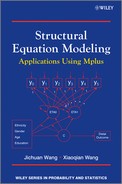Chapter 2
Confirmatory Factor Analysis
As discussed in Chapter 1, the key difference between path analysis and SEM is that the former analyzes relationships among observed variables, while the latter focuses on relationships among latent variables (latent constructs or factors). In order to conduct SEM, latent variables/factors must be defined appropriately using a measurement model before they are incorporated into a SEM model. Latent variables are unobservable and must be indirectly estimated from observed indicators/items. Traditionally, the exploratory factor analysis (EFA) technique is applied to assess factorial structure of a measuring instrument (Mulaik, 1972; Gorsuch, 1983; Comrey and Lee, 1992). EFA extracts unobserved factors from data without specifying the number of factors or without determining how the measurement items or the observed indicators are loaded onto which specific factors, instead, factors are defined after they are extracted. In other words, EFA is applied in situations where the factorial structure or the dimensionality of an instrument for a given population is unknown, usually in the situation of developing new instruments. In contrast, confirmatory factor analysis (CFA) (Bollen, 1989a; Brown, 2006) is used in situations where one has some knowledge of the dimensionality of the variables under study either based on a theory or empirical findings. The factors are theoretically defined, and how specific indicators or measurement items are loaded onto which factors is hypothesized before testing the model. Researchers wish to determine and confirm that the factorial structures of the scales in the instrument under study are as hypothesized. In application of CFA, researchers are interested mainly in evaluating the extent to which a set of indicators/items in a particular instrument actually measures the latent variables/factors they are designed to measure.
Compared with EFA, the advantages of CFA include, but are not limited to, the following: first, all factors in EFA are either uncorrelated (orthogonal) or correlated (oblique). In CFA, relationships among factors can be flexibly specified on a theoretical basis or based on empirical findings. Secondly, observed indicators/items in EFA are loaded onto all the factors; while observed indicators/items in CFA are only loaded onto factors that they are hypothesized to measure. However, an indicator may also be loaded onto one or more factors in a CFA based on a theoretical concern. As a result, a CFA model is not only theoretically more meaningful, but also is more parsimonious because the factor loadings of indicators to the irrelevant factors are all fixed, a priori, at 0 in a CFA model, thus substantially reducing the number of parameters to estimate. Thirdly, measurement errors are not allowed to be correlated in EFA, yet this is not the case in CFA. However, appropriate specifications of error correlations in CFA can be used to test method effects (Marsh, 1996; Tomá s and Oliver, 1999; Wang et al., 2001). Fourthly, unlike the traditional EFA, CFA can be simultaneously conducted in multiple groups so that measurement invariance across groups can be tested. Finally, covariates can be readily included to predict the factors, thus expanding the CFA model to a SEM model.1
In CFA, the link between the observed indicators/items and the factors is represented by factor loadings that are the regression paths from the factors to the corresponding observed indicators. A slope coefficient of regressing an observed indicator on a factor is the factor loading of the indicator on that factor, and the associated residual term is the corresponding measurement error in the indicator. As such, the measure of an observed indicator is separated into measurement error and the measure on the underlying factor. As a result, when we model the relationships between the factor/latent variables, the estimated relationships among latent variables would be free of the effects of measurement errors.
CFA is fundamental to SEM. One of the prevalent uses of SEM techniques is to study construct validity or to assess factorial structure of scales in the measuring instrument under study using CFA model. The first step of SEM is to ensure that the measurement models involved in the SEM are well- established and fit data well. In real research, when a SEM model does not fit data, it is most often due to problems in the corresponding measurement models.
In this chapter, we discuss some basics of CFA and demonstrate applications of CFA using Mplus with real world data. Some important issues in CFA modeling, such as how to deal with violation of multivariate normality assumption, censored measures, binary or ordered categorical measures, will be addressed using various CFA models. At the end of the chapter, we will expand our discussion from the first- order CFA model to a second- order CFA model.
